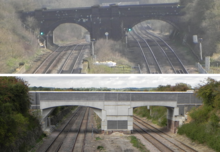
The West Coast Main Line (WCML) is one of the most important railway corridors in the United Kingdom, connecting the major cities of London and Glasgow with branches to Birmingham, Liverpool, Manchester and Edinburgh. It is one of the busiest mixed-traffic railway routes in Europe, carrying a mixture of intercity rail, regional rail, commuter rail and rail freight traffic. The core route of the WCML runs from London to Glasgow for 399 miles (642 km) and was opened from 1837 to 1869. With additional lines deviating to Northampton, Birmingham, Manchester, Liverpool and Edinburgh, this totals a route mileage of 700 miles (1,127 km). The Glasgow–Edinburgh via Carstairs line connects the WCML to Edinburgh. However, the main London–Edinburgh route is the East Coast Main Line. Several sections of the WCML form part of the suburban railway systems in London, Coventry, Birmingham, Liverpool, Manchester and Glasgow, with many more smaller commuter stations, as well as providing links to more rural towns.
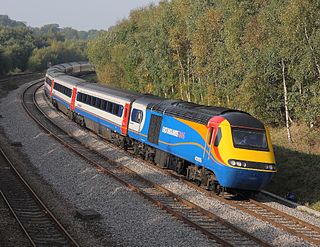
The Midland Main Line (MML) is a major railway line from London to Sheffield in Yorkshire via the East Midlands. It comprises the lines from London's St Pancras station via Leicester, Derby/Nottingham and Chesterfield.

Merseyrail is a commuter rail network which serves Merseyside and adjacent areas of Cheshire and Lancashire. Merseyrail serves 69 stations, 67 of which it manages, across two lines – the Northern Line and the Wirral Line. The network uses 750 V DC third rail electrified lines having 75.0 miles (120.7 km) of routes, of which 6.5 miles (10.5 km) are underground. Since January 2023, Merseyrail commenced replacing its train fleet, withdrawing the Class 507 and 508 trains and introducing 53 new Class 777 trains. The network carried 25.5 million passengers in the 2022/2023 statistical period.

Leicester railway station is a mainline railway station in the city of Leicester in Leicestershire, England. The station is managed by East Midlands Railway and owned by Network Rail. The station is served by CrossCountry and East Midlands Railway services. It is the busiest station in Leicestershire, the second busiest station in the East Midlands, and the fifth busiest station in the Midlands as a whole.

The East Coast Main Line (ECML) is a 393-mile long (632 km) electrified railway between its southern terminus at London King's Cross station and Edinburgh Waverley via Peterborough, Doncaster, York, Darlington, Durham and Newcastle. The line is a key transport artery on the eastern side of Great Britain running broadly parallel to the A1 road. The main line acts as a 'spine' for several diverging branches, serving destinations such as Cambridge, Leeds, Hull, Sunderland and Lincoln, all with direct services to London. In addition, a few ECML services extend beyond Edinburgh to serve Glasgow Central, although the principal London-Glasgow route is the West Coast Main Line (WCML).

England has a dense, multimodal transportation infrastructure. The Department for Transport is the government department responsible for the transport network in England. The Secretary of State for Transport is the member of the cabinet responsible to Parliament for the Department for Transport.

Corby railway station, owned by Network Rail and managed by East Midlands Railway, is in Corby, Northamptonshire, England. The current station, opened on 23 February 2009, replaces an earlier one dating from 1879, first closed on 18 April 1966 but reopened between 1987 and 1990.

Railway electrification in Great Britain began in the late 19th century. A range of voltages has been used, employing both overhead lines and conductor rails. The two most common systems are 25 kV AC using overhead lines, and the 750 V DC third rail system used in Southeast England and on Merseyrail. As of October 2023, 6,065 kilometres (3,769 mi) (38%) of the British rail network was electrified.

The period from 1995 covers the history of rail transport in Great Britain following the privatisation of British Rail. During this period, passenger volumes have grown rapidly, safety has improved, and subsidies per journey have fallen. However, there is debate as to whether this is due to privatisation or to better government regulation. During this period, High Speed 1, the West Coast Main Line upgrade and Crossrail were completed and more construction projects are currently under way. The period also saw the demise of privately-owned Railtrack and its replacement with government-owned Network Rail.

High Speed 2 (HS2) is a high-speed railway which is under construction in England. It will run between Handsacre, in southern Staffordshire, and London, with a spur to Birmingham. HS2 is to be Britain's second purpose-built high-speed railway after High Speed 1, which connects London to the Channel Tunnel. The majority of the project is planned to be completed between 2029 and 2033.

The Northern Hub was a rail upgrade programme between 2009 and 2020 in Northern England to improve and increase train services and reduce journey times between its major cities and towns, by electrifying lines and removing a major rail bottleneck in Manchester. It was predicted to stimulate economic growth in the region. The project had several elements but the prime objective was to eradicate the bottleneck in Manchester and allow trains to travel through the city at speed without stopping. The project was announced as the Manchester Hub in 2009. The project's steering partnership involved Network Rail, Deutsche Bahn, First TransPennine Express, Northern Rail, East Midlands Trains, CrossCountry, Freightliner, the Department for Transport, Transport for Greater Manchester and Merseytravel.
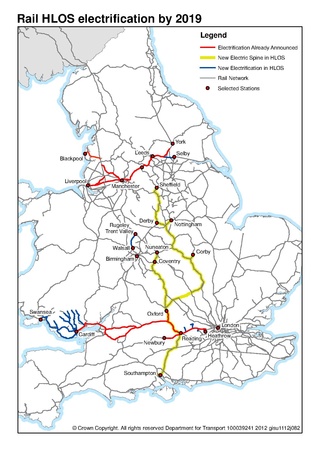
The "Electric Spine" was the name for part of a, now largely cancelled, rolling programme of railway electrification projects in England initially estimated to cost £800 million, but later thought to cost close to £3 billion. The aim was to form 25 kV AC overhead-wire electrified links northward from the Port of Southampton to major cities in northern and central England and dry port container terminals in the Midlands. The government wanted efficient electric-hauled freight trains to compete with road haulage.

Northern Powerhouse Rail (NPR), sometimes referred to unofficially as High Speed 3, is a proposed major rail programme designed to substantially enhance the economic potential of the North of England. The phrase was adopted in 2014 for a project featuring new and significantly upgraded railway lines in the region. The aim is to transform rail services between the major towns and cities, requiring the region's single biggest transport investment since the Industrial Revolution. The original scheme would have seen a new high-speed rail line from Liverpool to Warrington continuing to join the HS2 tunnel which it would share into Manchester Piccadilly station. From there, the line would have continued to Leeds with a stop at Bradford. The line was intended to improve journey times and frequency between major Northern cities as well as creating more capacity for local service on lines that express services would have been moved out from.
The Campaign to Electrify Britain's Railway (CEBR) is an internet-based campaign group formed in 2018 whose aim is to convince the government to completely electrify the British Railway network. Its slogan is "Down with Dirty Diesel." The campaign promotes a rolling programme of electrification, which it considers essential to improve UK railways and help to decarbonise transport. It collaborates with groups such as the Railway Industry Association, Rail Delivery Group, Birmingham Centre for Railway Research and Education, Campaign for Better Transport, Institute of Electrical Engineers and the Permanent Way Institution. The group has given evidence to the Transport Select Committee. Huw Merriman the committee chair at the time, put it writing he agreed with their view. Merriman was appointed as Minister of State for Rail and HS2 in October 2022. The desire to achieve net zero carbon in transport has increased calls for electrification.
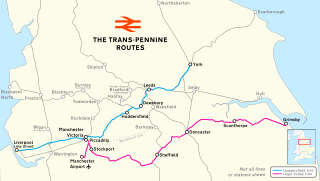
The Transpennine Route Upgrade (TRU) is a major investment being made in the railway between York and Manchester via Leeds and Huddersfield – the 76 miles (122 km) northern route over the Pennines, most of which is also known as the Huddersfield line. As of 2023, the line is heavily used but is slow and lacks capacity. It has Victorian infrastructure, covers difficult terrain including the 3-mile (4.8 km) Standedge Tunnel, and has poor access roads.

The Midland Main Line upgrade is an ongoing upgrade to the Midland Main Line (MML), a major railway line in the United Kingdom. There have been a number of proposals to electrify the line over many years but the 2012 proposal and announcement by the UK government was that it would include electrification of the railway line between Bedford, Wellingborough, Corby, Leicester, Derby, Nottingham and Sheffield. The routes between Nottingham and Sheffield and the Erewash Valley line were not included at this time, only the line between Derby and Sheffield. The upgrade was part of the HLOS - High Level Output Specification for Control Period 5 published by the UK Government in 2012. This was also part of a rolling programme of railway electrification projects. To enable all the benefits of using electric traction, the line south of Bedford into London St Pancras is also being progressively upgraded including boosting the power supply. Parts of the line have been classed as congested infrastructure hence another reason for the upgrade.
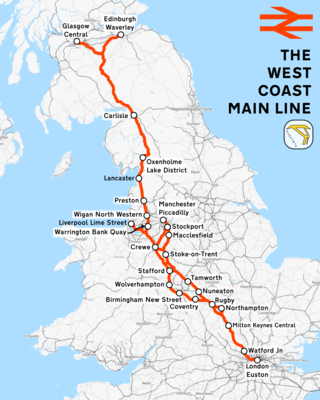
The West Coast Main Line is a key strategic railway line in the United Kingdom. It links the cities of London, Glasgow, Birmingham, Liverpool, Manchester, Preston, Lancaster and Carlisle. Virgin Trains took on the franchise to run train services on the routes in 1997 and as part of the agreement wanted an upgrade to the railway line to allow for faster more frequent trains to grow the business. The upgrade started in 1998 and was completed in 2009. It came under parliamentary and media scrutiny because of cost and schedule overruns. Further improvements such as the Norton Bridge rail flyover were completed after these dates. The project is sometimes given the acronym WCRM - West Coast Route Modernisation.
North West England electrification schemes are a series of individual railway lines in North West England that have been, and continue to be electrified and upgraded. It is planned that these schemes will result in a modernised, cleaner, lower carbon and faster railway with improved capacity.
The Felixstowe to Nuneaton railway upgrade in the United Kingdom is a series of upgrades being made to both a key strategic freight route and one that carries passengers on many parts. It is one of only two routes between the busiest container port and the Midlands, the other being via London. The route and the upgrade is sometimes abbreviated to F2N. The railway route includes the Birmingham–Peterborough line for a large part. The line links the Port of Felixstowe in Felixstowe, Suffolk, with the Midlands and crosses the East Coast Main Line, the Midland Main Line and the West Coast Main Line and thus the north and Scotland. From Nuneaton, a number of intermodal terminals may be reached. Much infrastructure in the UK is of Victorian origin and thus needed an upgrade; F2N, being a key route, is no exception.
Railway electrification in Scotland has proceeded in a different fashion than the rest of the UK especially in the 21st Century. There is political commitment to a substantial rolling programme of railway electrification from the Scottish government where transport is devolved. Transport Scotland and others have said "In Scotland, decarbonisation is spelt E-L-E-C-T-R-I-F-Y". All parties in Scotland are vigorously campaigning for electrification. As of January 2022, there are 2776 kilometres of track in Scotland, and 711 kilometres are electrified representing 25.3%. To meet these needs, the plan is to electrify on average 130 single track kilometres (STK) per year until 2035, although there has been some slippage in this target.

